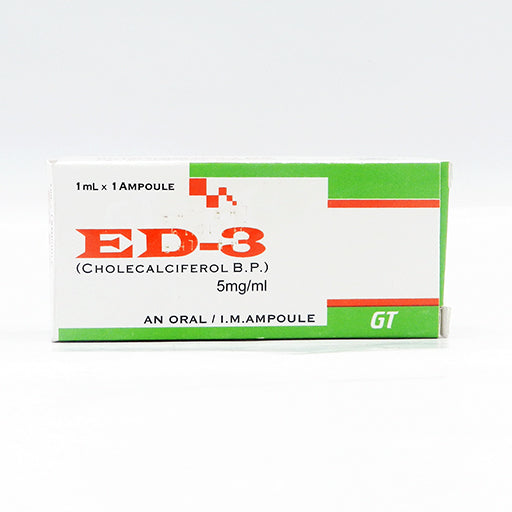Your cart is currently empty.
ED-3 5 mg / 1 mL Injection (Cholecalciferol / Vitamin D3) — 1 Ampoule
: Available:
QUESTIONS & ANSWERS
Have a Question?
Be the first to ask a question about this.
Category:

Description
ED-3 is an injectable preparation of vitamin D3 (cholecalciferol) intended for intramuscular administration. It is often used in cases of severe vitamin D deficiency or when rapid replenishment is needed. It comes as a sterile solution in a 1 mL ampoule containing 5 mg of cholecalciferol (≈ 200,000 IU).
Ingredients
-
Active ingredient: Cholecalciferol (Vitamin D3), 5 mg per 1 mL ampoule
-
Excipients: As per manufacturer’s formulation (may include oils or solubilizers; check the specific leaflet)
Drug Class
-
Vitamin / Nutritional supplement
-
In particular, a fat-soluble vitamin (vitamin D3) used for correction of deficiency
Dosage Form
-
A sterile solution in a 1 mL ampoule for intramuscular injection
-
Single-use ampoule
Uses / Indications
ED-3 injection is indicated for:
-
Treatment of vitamin D deficiency in cases where high dose or parenteral administration is required
-
Prevention of deficiency in individuals with malabsorption or gastrointestinal disorders impairing oral absorption
-
In bone disease contexts such as osteomalacia, osteoporosis, or rickets (in conjunction with calcium)
Dosage
-
A single dose of 5 mg (≈ 200,000 IU) is common for correction of deficiency in many protocols. Depending on response, repeat doses may be given (e.g. after several months) if deficiency persists.
-
The exact dose and frequency should be determined by a physician based on patient’s vitamin D levels, calcium status, kidney function, and other clinical factors.
In Case of Overdose
-
Vitamin D toxicity (hypervitaminosis D): May lead to hypercalcemia, which can cause symptoms such as nausea, vomiting, weakness, polyuria, polydipsia, confusion, arrhythmias, renal damage, and calcification of soft tissues.
-
Management is supportive: discontinue vitamin D, limit dietary calcium, ensure hydration, consider use of corticosteroids, bisphosphonates, or other measures to reduce calcium levels under medical supervision.
Missed Dose
-
Infrequent dosing makes “missed dose” less critical; administer as soon as possible if safe and within protocol, or follow physician’s plan.
-
Avoid doubling the next dose due to risk of toxicity.
How To Use / Administration Instructions
-
Inspect the ampoule visually; the solution should be clear (or as per label) and free of particulate matter or discoloration.
-
Use aseptic technique.
-
Administer via intramuscular injection, typically into large muscle (e.g. deltoid or gluteal).
-
Apply light pressure at injection site after administering; avoid rubbing.
-
Monitor for local reaction and general symptoms.
When Not to Use / Contraindications
-
Known hypersensitivity / allergy to vitamin D3 or any excipient
-
Hypercalcemia or hypercalciuria
-
Conditions predisposing to hypercalcemia (e.g. sarcoidosis, certain granulomatous diseases)
-
Severe renal impairment or sarcoidosis (unless benefits clearly outweigh risks)
-
Patients with kidney stones or predisposition to calcification
Side Effects / Adverse Reactions
Common / mild:
-
Pain or mild irritation at injection site
-
Nausea, vomiting
-
Weakness
-
Increased thirst, frequent urination
Serious / less common:
-
Hypercalcemia symptoms (as above)
-
Kidney stones, renal impairment
-
Soft tissue calcification
-
Cardiac arrhythmias
-
Neurological symptoms (confusion, lethargy)
Precautions & Warnings
-
Monitor serum calcium, phosphate, and renal function periodically.
-
Use caution in patients with renal disease.
-
Avoid concomitant high-dose calcium supplements unless monitored.
-
Be cautious when using with other vitamin D supplements to avoid cumulative overdose.
-
Monitor for signs of hypercalcemia.
Drug Interactions
-
Thiazide diuretics: may increase risk of hypercalcemia. Phenytoin, barbiturates: may increase metabolism of vitamin D, reducing its effect.
-
Glucocorticoids: may antagonize vitamin D effects on calcium absorption.
-
Digoxin: risk of arrhythmias may increase with hypercalcemia.
-
Magnesium / aluminum antacids, cholestyramine: may impair absorption if oral forms used; less relevant for injection but may influence overall vitamin D status.
Storage / Disposal
-
Store at temperatures as per label (avoid excessive heat).
-
Protect from light.
-
Do not freeze.
-
Dispose of used ampoules in sharps containers / follow biomedical waste regulations.
Control Drug / Prescription Status
-
May be prescription or controlled, depending on local regulation (vitamin D injections usually require medical supervision).
-
Should only be administered by a qualified healthcare professional.
Quick Tips
-
Always verify the cumulative vitamin D intake from all sources (oral supplements, diet, injection) to avoid overdose.
-
Use this injection especially in cases where oral absorption is impaired or rapid correction is needed.
-
Monitor calcium and renal indicators before repeating doses.
-
Educate patient on signs of hypercalcemia (nausea, confusion, frequent urination, muscle weakness).
-
Label clearly and keep away from children.
Your order of 100$ or more gets free standard delivery.
- Standard delivered 4-5 Business Days
- Express delivered 2-4 Business Days
Orders are processed and delivered Monday-Friday (excluding public holidays)
eMarket members enjoy free returns.
Related Products

Categories
Custom HTML Text
-
Free Delivery
From Rs 5000
-
Support 24/7
Online 24 hours
-
Free return
365 a day
- Choosing a selection results in a full page refresh.
Added to cart successfully. What's next?

Product type: 1
1 x $00.00






















 Chat with Us
Chat with Us